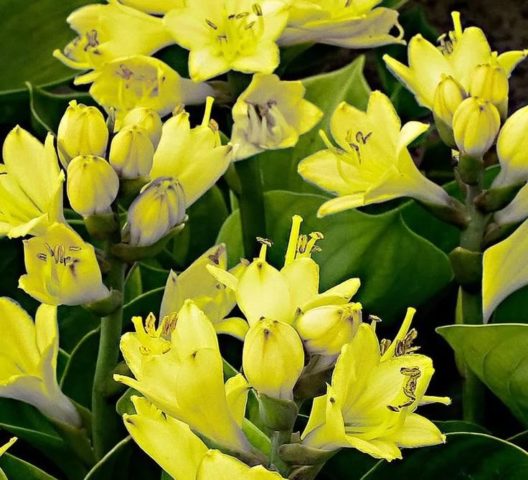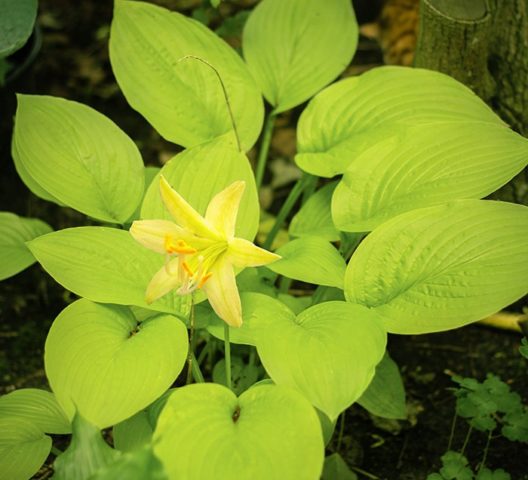Content
The yellow hosta is especially popular among flower growers. They are attracted not only by the unpretentiousness of the plant, but also by the possibility of creating decorative points in the country or in a personal plot.
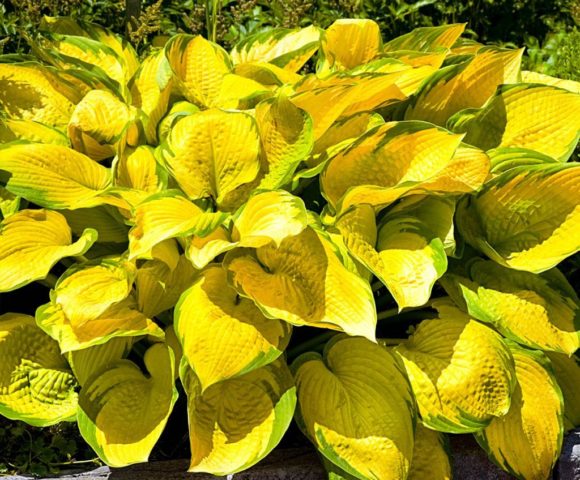
Almost all host varieties with yellow leaves can grow in open, sunny places.
Benefits of yellow-leaved host
Hosts are also called functions, they occupy part of the garden for lovers of plants with bright leaves. It's all about the virtues of culture:
- The flowers are unpretentious, they can grow in almost any region, they are unpretentious to the composition of the soil.
- Leaf blades have different shapes and sizes. There are varieties of yellow-green host with a smooth and wrinkled, matte and grooved surface.
- Bushes with beautiful leaves go well with many garden crops. This characteristic attracts designers.
- You can choose any place for landing, the main thing is to take into account the resistance to sunlight.
- Yellow leaves on long stalks are no less appreciated by the creators of bouquets.
- Using plantings of different heights, you can come up with all kinds of flower arrangements in the garden.
- In one place, yellow hosts have been growing for more than 20 years.
If this is the first time a host is landing a yellow host, you may be mistaken in choosing a place. You don't need to worry. The next year, you can move the bush, since the plants tolerate transplanting well. Only decorativeness will not appear immediately, but after three years.
The best types and varieties of host with yellow leaves
Breeders are constantly adding to the list of species and varieties of decorative hosts with yellow leaves. To choose plants for your site, you will have to familiarize yourself with the description and features of growing a crop.
Sun Power
Hosta Sun Power is one of the popular varieties. In early spring, the leaf blades are yellowish-green. In the summer, when the day becomes long, a golden color appears in them, which is not lost until the fall.
The lower part of the leaf has a whitish bloom. All veins are clearly visible from above. Hosta Sun Power blooms in the middle of summer. Funnel-shaped lavender buds bloom on the peduncles.
The bush has the shape of a fountain, the height together with the petioles is up to 70 cm.The width grows up to 90 cm.

Hosta Sun Power can grow in the open sun, but it is best to find a place with an openwork shade
Cinderella
This variety is placed not only outdoors as tapeworms. The plant feels great on windowsills. The height of the bushes with yellow leaves is almost 50 cm, the diameter is within 110 cm.
Hosta is represented by large leaf blades that look like hearts. The edges with a wide border are yellow and the middle is green. Thanks to the clear veins, the host looks decorative.

Hosta Cinderella in the foreground surrounded by other species
Francis Williams
Khosta yellow Frances Williams stands out with large leaves of green-blue color in the shape of a heart. A yellowish-cream edging is clearly visible along the edge. The bushes grow up to 80 cm, their width is within 130 cm.

The decorativeness of the leaves of this yellow hosta variety is best manifested in the light shade of trees.
Captain Kirk
Hosta Captain Kirk is a yellow-green variety. The bushes have wrinkled light green leaves with a well-defined border of dark green color. Flowering begins in late July or early August.Pink-purple small buds bloom on tall peduncles.
Plants need a lot of light in the morning, but the day's rays can be detrimental to foliage.

The height of the Captain Kirk bush is up to 70 cm, for successful growth an area of at least 90 cm is required
Orange Marmalade
The yellow hosta Orange Marmalade is an amazingly beautiful plant. It attracts attention with its orange core and bluish border. The leaf blades are wide, oval, and compressed.
The plant is hygrophilous, so it is appropriate to plant it near water bodies. Can grow in light shade. The height of a bush with yellow leaves is slightly more than half a meter, the required area for successful development is within 1 m.
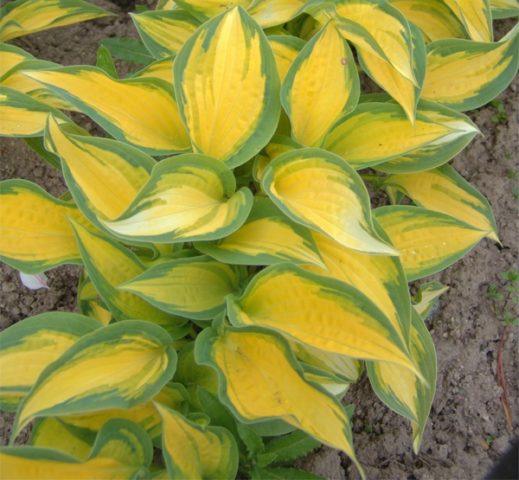
The host is frost-resistant, able to withstand frost up to 30 degrees without damage, so it does not need shelter
First Frost
The First Frost variety is new, not every culture lover grows on the site. The best planting sites are rockeries and Japanese stone gardens.
This hosta is undersized. It has amazingly beautiful bluish leaves with a milky-lemon border around the edges. Due to this, they are highly decorative. The leaves are wide, more than 60 cm. During the growing season, the color may change. At first the plates are light green, then deep blue.
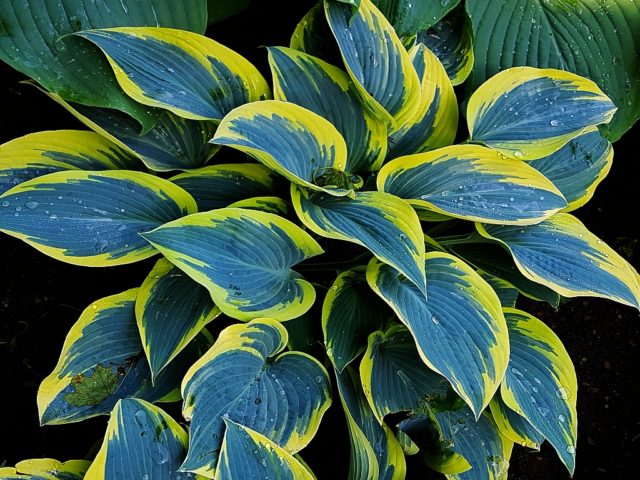
First Frost yellow leaves color depends on air temperature
Sam and Substance
Sum and Substance yellow funkii leaf blades are bowl-shaped. The tip is long and the blades are deep. The rosette of the bush is capacious and dense enough, so snails and slugs practically do not annoy the plant.
The color of the leaves depends on the planting site. In open areas it is golden yellow, in an openwork shade - light green.
The variety is moisture-loving. When optimal conditions are created, the bush reaches a height of 1 m, a diameter of about one and a half.

Yellow hosta blooms in July, buds are small, light purple hue
Gold standard
The Gold Standard variety has large egg-shaped leaf blades. After waking up, they are pale green with a dark border. During the growing season, the color changes to golden, but the dark green color does not disappear along the edge.
The height of the yellow hosta is about 70 cm, the width of the bush is more than 150 cm, so you need to choose a spacious place for planting. Flowering begins in July and lasts until August. The buds are light lilac, located on peduncles up to 1 m long.
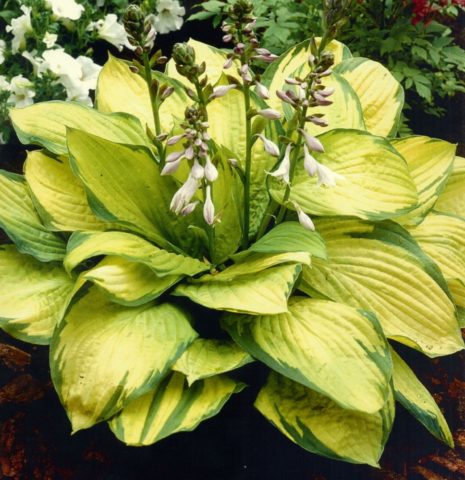
For the winter, the yellow hosta does not need to be covered, since the Gold Standard variety is frost-resistant
Lemon Delight
The yellow function of Lemon Delight is a short plant. It stands out among its congeners with leaves with slightly wavy edges. The middle of the plate is green, and the border is golden. For planting, it is advisable to choose partial shade so that the color manifests itself as much as possible.
Bushes grow quickly when conditions are good. The height of the yellow hosta Lemon Delight is no more than 20 cm, in diameter - about 40 cm.
In July, flower stalks with bright purple buds rise above the leaves. There are so many of them, it seems that hats were put on the yellow bushes.

Although the Japanese consider the Lemon Delight plant sacred, they will not give up the delicious salad made from its petioles.
Aureomarginate
Funkia variety Aureomarginata stands out for its large dark green leaves. The border is yellow, wide, in the form of feathers. The bush grows quickly, reaching a height of 75-80 cm. It requires a lot of space for planting, since it is about 1.5 m in diameter.
Yellow hosta Aureomarginate refers to unpretentious cold-resistant plants. They can be planted in partial shade. They grow on any soil.
Flowering begins in mid-July. Light purple bells appear on the peduncles. The buds are pleasing to the eye for at least three weeks.

Variegated varieties of yellow funky need a lot of sun, in the shade, the color fades, loses its decorative effect
First Mate
First Mate has long, pointed, wedge-shaped leaves. There is a dark green border along the edges, the center is creamy yellow. To increase decorativeness, hosta bushes are recommended to be planted in the shade or partial shade.
Plant height - about 25 cm, diameter - up to 60 cm. It blooms in July-August. The buds are small, purple in color.
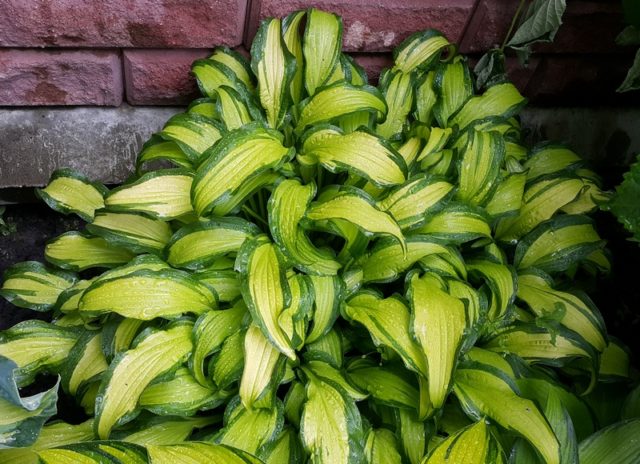
The flowers of the yellow First Mate hosta are inconspicuous, therefore, to preserve the decorative effect of the bush, they can be removed
Dancing Queen
The yellow function of the Dancing Queen has a vase-like bush shape. By the age of six it reaches a height of 60 cm. Leaves are yellow-lemon, retain their hue in spring and until mid-summer. Then the plates turn green.
For decorative purposes, the dancing Queen is recommended to be placed in partial shade, so that the sun hits the hosta foliage only until noon. This will help keep the yellow color longer.
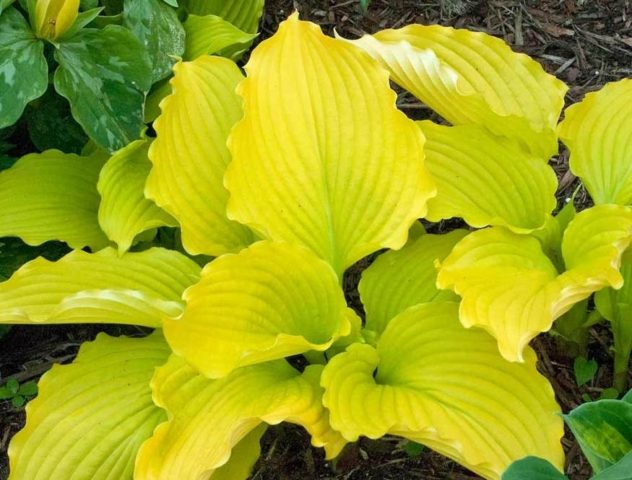
Hosta the Dancing Queen looks great among green fellows or next to geyher
June Fever
Designers appreciate June Fever for its dense yellow leaves with an emerald border. You need to plant in the sun, otherwise the decorative effect of the bush will be lost. The plant is medium in size, no more than 40 cm in height. The June Fever yellow funkia bush grows slightly. The diameter is only 70 cm.

June Fever is a flowering plant with light purple buds appearing at the end of July
Aureomakulata
The function of the variety Aureomaculata belongs to medium-sized plants. The height of the bush is about half a meter, the diameter is about 0.8 m. The leaf blades are two-colored. In the center - yellowish-green with cream-colored stripes. There is a well-visible border of a dark green hue along the edge.
The color changes by autumn, the leaves turn green.
Flowering begins in late summer, purple buds.
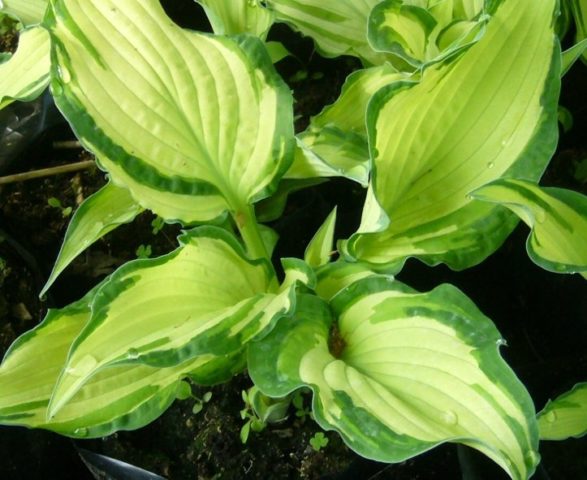
The variety Aureomaculata is light-loving; it is advisable to plant the crop in the sun to preserve the variegated color
Dutch flame
Dutch Flame hosta leaves have a green center and a yellow-white border in the form of feathers growing on red petioles. The plates are distinguished by their elongation and density. The bush is up to half a meter high, it grows 80 cm wide. It blooms with lavender buds in the middle of summer.
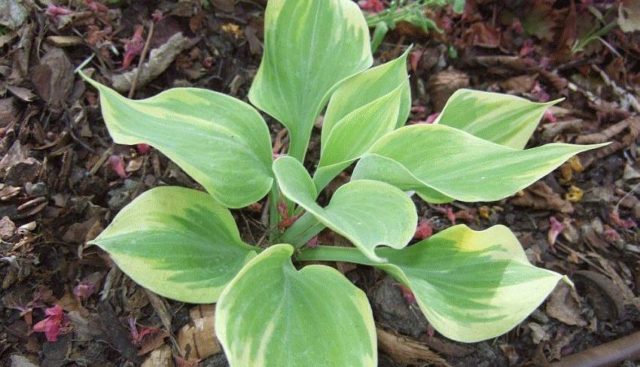
Hostu Dutch flame can be safely planted in the dark corners of the garden
Hosta varieties with yellow flowers
Sadly, there is almost no funky with yellow buds. There are only a few varieties. Among them:
- Miracle Lemony (Miracle Lemony). The variety has light green leaf blades. The edges are slightly wavy. Better to plant in shade or partial shade. Inflorescences are light lemon.
Up to eight bell-shaped buds bloom on medium-length Miracle Lemony flower stalks
- Lemon Miracle (Hosta Miracle Lemony). The foliage is in the form of a slightly elongated lemon-colored heart. The plates are glossy. Adult plants grow up to 40 cm. Flowers are large - up to 4-5 cm in diameter. The buds are pale yellow, reminiscent of a lily.
New Hosta Miracle Lemony variety that can be used for curbs
- Hosta Limoncello (Hosta Lipstick Blonde). The height of the bush is about 42 cm. Pastel yellow leaves are wrinkled, in the form of a spear. The edges of the yellow plates with a waxy coating are corrugated. The leaves grow on red petioles. Flowering begins in June, yellow buds.
Frost resistant Lipstick Blonde, mid-June bloom
Yellow hosts in landscape design
Hosts with yellow leaves have long attracted landscape designers. They like not only the decorativeness of plants, but also resistance to frost, unpretentiousness. For the function to show itself in all its glory, you need to wait 3-4 years, and sometimes five years. It is also important to choose the right landing site.

Bushes with yellow-green leaves will decorate any flower garden, look great against the background of conifers
The hosts are peaceful, they get along with almost all garden crops:
- geraniums and lungwort;
- primrose and foxglove;
- mountain woman and astilba;
- gladioli and hydrangeas;
- peonies and roses;
- delphiniums and gerberas;
- daylilies and phloxes.

Successful tandem - yellow hosts and scarlet peonies
The culture can be planted:
- in flower beds;
- next to trees;
- on the alpine slides;
- in rockeries;
- as a groundcover.
It is these plantings of the hosts when decorating the track that allow you to create unique flower arrangements. You just need to choose the right garden crops so that they are combined with each other and do not hide the beauty of each other.
So that a flower bed, rockery or alpine slide does not look flashy, designers recommend using no more than three different plants. Yellow hosts look great in mono-plantings. You can only plant one species or different plants. The main thing is to correlate the height and width of the bushes so that they do not shade each other.
There are many options for using yellow hosts in design, below are some of them.
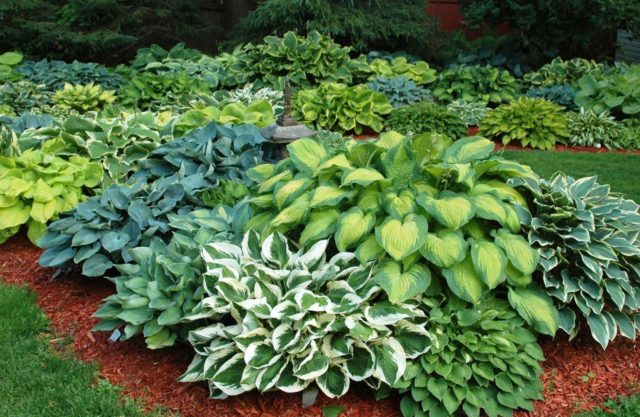
Different varieties of host with colored leaves look great

In the park, where there is a stream, the very place for funkya

Hosts inside a thuja or juniper flower bed

Any garden flowers can be neighbors of yellow funky
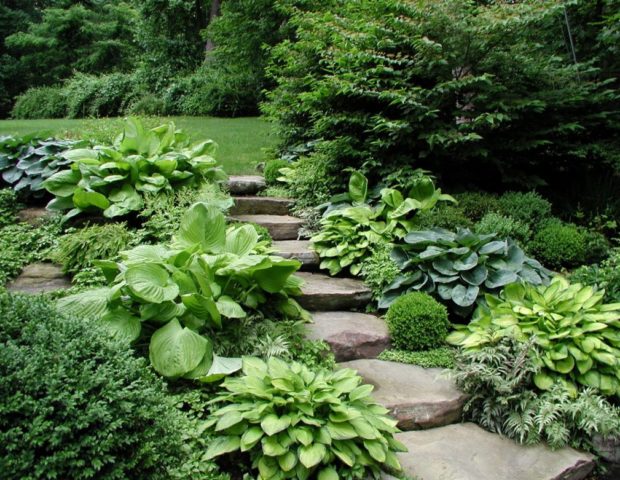
Stone staircase framed by plants with colorful leaves

Against the background of many colors, yellow foliage looks especially expressive.
Planting and leaving
Although the plants are mostly unpretentious, to get an ornamental shrub, you need to know some of the planting and care features.
As a rule, varieties are propagated by rosettes. They are planted in early spring or October. It all depends on the recommendations and the region. To avoid further problems, the planting material is cleaned of damage and treated with special means. Before planting, soak the rosettes for a short time in a growth stimulator.
Since hosts have been growing in one place for more than 20 years, the soil is well fertilized. A distance is left between the plants, which is characteristic of their width, so that in the future there is enough space for the bushes to develop.
The site is chosen depending on the description of the variety: in the sun or in partial shade. Water regularly, as the culture is moisture-loving.
Diseases and pests
Like any garden plants, hosts suffer from diseases and pests. It is advisable to choose varieties with good immunity. If necessary, treat the planting with special preparations. As for pests, most often the plants are annoyed by slugs and snails. They are destroyed with pesticides.
Conclusion
The yellow hosta is an amazingly beautiful plant. The bushes have been developing for several decades in one place. They tolerate the transplant well. Plants go well with other garden crops, so it is possible to create unique flower arrangements. That is why the function is becoming more and more popular.
